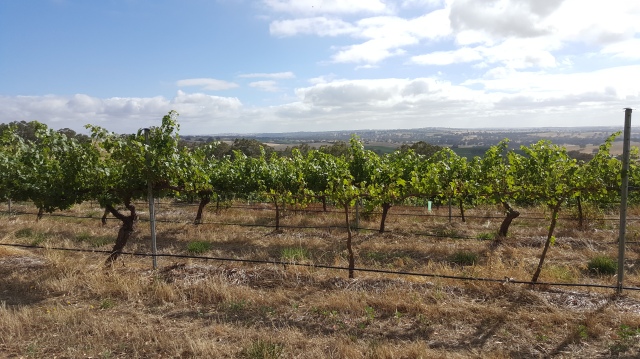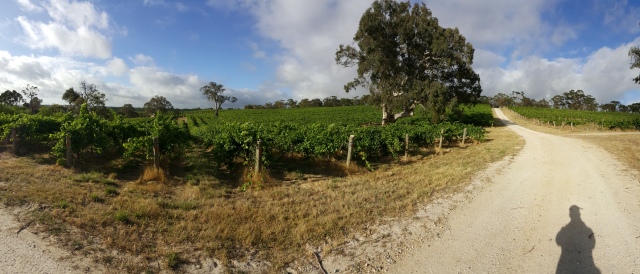As I continue to write about my time in South Australia, I really want to make sure I cover perhaps its most famous and one of its most profitable exports – wine.
Wine in Australia is big business – between September 2016 and September 2017, almost 800 million liters of wine worth nearly $2.5 billion was exported from the country, roughly equal to about 0.2% of the country’s entire GDP in 2016. More of this wine was produced in the state of South Australia than in the other states combined – over 400 million liters, or enough to fill more than 160 Olympic-sized swimming pools. Most of this wine makes its way to huge export markets like the United States and China, but some also goes to international competitions, where it is ranked on equal footing with globally renowned wine-producing regions such as Bordeaux and Napa Valley. In fact, in the 2017 World Ranking of Wines and Spirits, a South Australian wine was named the top wine of the year; in the past 5 years of this competition, a South Australian wine has taken this honor 3 times.
*record scratch* You’re probably wondering how South Australia ended up in this position. Well, it hasn’t always been this way…

A brief and blunt overview of the Barossa geography
Although I really don’t know enough about wines, viticulture or the geography of South Australia to speak about this with any authority, I suppose some quick researching is in store to help me tell a more historically-accurate story.
For this post, I’ll be focusing on the Barossa zone, one of the most well-known wine regions in South Australia. There are of course other impressive wine-producing regions in the state and lots of minutiae that I’m leaving out (McLaren Vale, Adelaide Hills, but frankly I don’t know enough to talk about them in any detail), so I’ll keep it simple and hopefully correct. The Barossa Valley proper feels and looks a good bit like the Central Valley of California, where I’ve grown up and lived – walled in by mountain ranges, rather hot and dry weather (at least in the summer), and rich soils. The Barossa zone also encompasses the Eden Valley, which is more hilly and chilly and has generally rockier soils. Together, these abiotic factors constitute a wine’s terroir, a French term used to describe the environment in which a wine is produced and the resulting nuances in its flavor.
Once again, I’m really oversimplifying things, and I won’t be surprised if I’m misleading, missing details or even blatantly wrong in areas…but I’m doing my best to get the basic idea there. Maybe I’ll rewrite this when I’m 21.

Germans and cheap wine: the origins of Barossa wine production
The story of the Barossa zone begins in the mid-19th century, not with British prisoners (as much of the rest of modern Australia did) but with Germans fleeing Silesia. Although the heyday of the classic mercantilist colony had since passed (and spawned the United States in it), the idea of wealthy people getting together to fund new settlement and turn a profit was very much alive when one George Fife Angas helped start the South Australian Company in 1835. Six years later, Angas promised safety and free land to Silesian refugees who were willing to help farm the land of the Barossa Valley, and they settled on wine as a suitable crop for the Mediterranean climate in the region.
The first grape grown widely in the Barossa Valley was Riesling, a German grape used to make white wine. However, this grape typically prefers cooler climates (like those found in the Eden Valley – more on that later), so it often went overripe in the hot Barossa summers. These grapes were used for the production of fortified wines – wines mixed with other spirits like brandy – so the Barossa was first known for this style. The region continued to create “Port-style wines”, similar to those famous for being produced in Portugal, with the introduction of a red grape from southeastern France, called Syrah or more commonly Shiraz.
In the middle of the 20th century, Australia turned its sights on Cabernet Sauvignon, a very famous and widely-cultivated hybrid grape used for the production of high-quality red wines. The region of Coonawarra, in the southeast of South Australia about halfway between Adelaide and Melbourne, eventually became the focal point for Australian cultivation of this grape. The Barossa Valley was largely passed up because by this time, it had gained a poor reputation for producing “cheap” Shiraz only used for fortified wine or as filler in low-quality blends of wine grapes.

Old vine Shiraz: The Barossa Renaissance
It was around this time, the middle of the 20th century, that independent winemakers in the Barossa and the wine regions surrounding Adelaide began to experiment with the grapes that they had in an attempt to create something that could compete with the European quality. Perhaps the most famous of these is Penfolds Grange, a cult wine consisting of predominately Shiraz grapes (nowadays a tiny amount of Cabernet Sauvignon is often mixed in as well), which was first created in 1951 by Max Schubert through a marriage of the unique Australian terroir and classic European winemaking techniques. Its first few vintages were viciously criticized due in part to its undeveloped taste and the existing prejudice against wines of the area – one review described it as “a concoction of wild fruits and sundry berries with crushed ants predominating” and another person called it “a very good, dry port, which no one in their right mind will buy – let alone drink”, a not-so-subtle insult to the region’s winemaking history. In fact, in 1957, the Penfolds company forbade the further making of the wine. But Schubert, believing in his ability to create a masterpiece, continued in secret by reducing the quantity made and reusing hogshead barrels, and by the 1960s, the last decade’s Granges had matured marvelously. When entered into competitions, these took home dozens of gold medals and other awards, with the famed 1955 vintage meeting great success, and the company ordered production to start again (although it had never really stopped). Nowadays, the Penfolds Grange, Bin 95, is arguably Australia’s most famous wine, and good vintages can sell for hundreds or thousands of dollars.
Penfolds Grange is perhaps the best-known example of revitalizing and indeed discovering the South Australian Shiraz style, but it is not the only one. Throughout the second half of the 20th century, many other wineries began to experiment with and create high-quality Shiraz wines from decades-old vines, completely changing the perception of the Barossa Valley. Far from producing cheap fillers for blended wines, the region was now proudly displayed on labels of bottles of Old Vine Shiraz. As the new millennium began, well-established wines like Penfolds Grange continued to excel as newer wineries added to the prestige of the Barossa; in 2013, for example, the World Ranking of Wines and Spirits named the 2010 vintage of Gatt Wines Old Vine Shiraz as the top wine in the world, and the other top 4 wines in that competition were all Shiraz from the same winery.

The Barossa zone today
The Barossa zone is now well established as a top producer of high-quality Shiraz wines, using the grapes to produce traditional red wine as well as sparkling varieties and rosé wines as well. However, it has diversified greatly with the knowledge of the region’s potential. Cabernet Sauvignon has since been established in the region and used to produce exceptional wines – one, for example, won the prestigious Warren Winiarski trophy for best Cabernet Sauvignon at the International Wine and Spirit Competition in 2014, beating out wines from more traditional locales such as Coonawarra or Napa Valley. Riesling remains an important varietal but is now more commonly grown in the cooler Eden Valley where it can produce quality wines, alongside the white grapes Semillon and Chardonnay. And the experimentation with and production of wines from European grapes less familiar to the American ear – Grenache, Sangiovese, and Mataró – continues, where Pinot Noir and Zinfandel are less common.

Conclusion
So that’s a little bit on the history and current state of the Barossa zone of South Australia and its famous wine. Sadly, I’m not old enough to sample and talk directly about the tastes and flavors of the wine, so all of what I know is pulled from talking with people in the area and some web research. But it’s definitely interesting to me, and I hope it has been interesting and informative for you as well. If you’re over 21, come visit South Australia and maybe taste a bit of the wine here as well! As Max Schubert said, we must “be prepared to experiment in order to gain something extra, different and unique in the world of wine” – and I think that that goes for both the consumer as well as the winemaker. Stay tuned.

Works cited:
Burt, J. (2017, October 19). Aussie wine export growth continues as Chinese market soars. Retrieved January 03, 2018, from http://www.abc.net.au/news/rural/2017-10-19/aussie-wine-continues-booming-growth-in-china-as-exports-rise/9066208
Gatt Wines Barossa Cabernet Sauvignon Proclaimed World’s Best. (2014, November 19). Retrieved January 03, 2018, from http://www.distinguishedwines.com/uncategorized/gatt-wines-barossa-cabernet-sauvignon-proclaimed-worlds-best/
H. Johnson Vintage: The Story of Wine pg 348-349 Simon and Schuster 1989
H. Johnson & J. Robinson The World Atlas of Wine pg 308-309 Mitchell Beazley Publishing 2005
J. Robinson Jancis Robinson’s Wine Course Third Edition pg 312-314 Abbeville Press 2003
Max Allen, The History of Australian Wine: Stories From the Vineyard to the Cellar Room, Carlton, Victoria: Victory Books, 2012, p. 91
Schubert, M. (n.d.). History of Penfolds Grange. Retrieved January 03, 2018, from https://www.artisanwinestorage.com.au/methuselahs/history-of-penfolds-grange
World Ranking of Wines and Spirits. (n.d.). Retrieved January 03, 2018, from http://www.wawwj.com/2017/_EN/index.php
